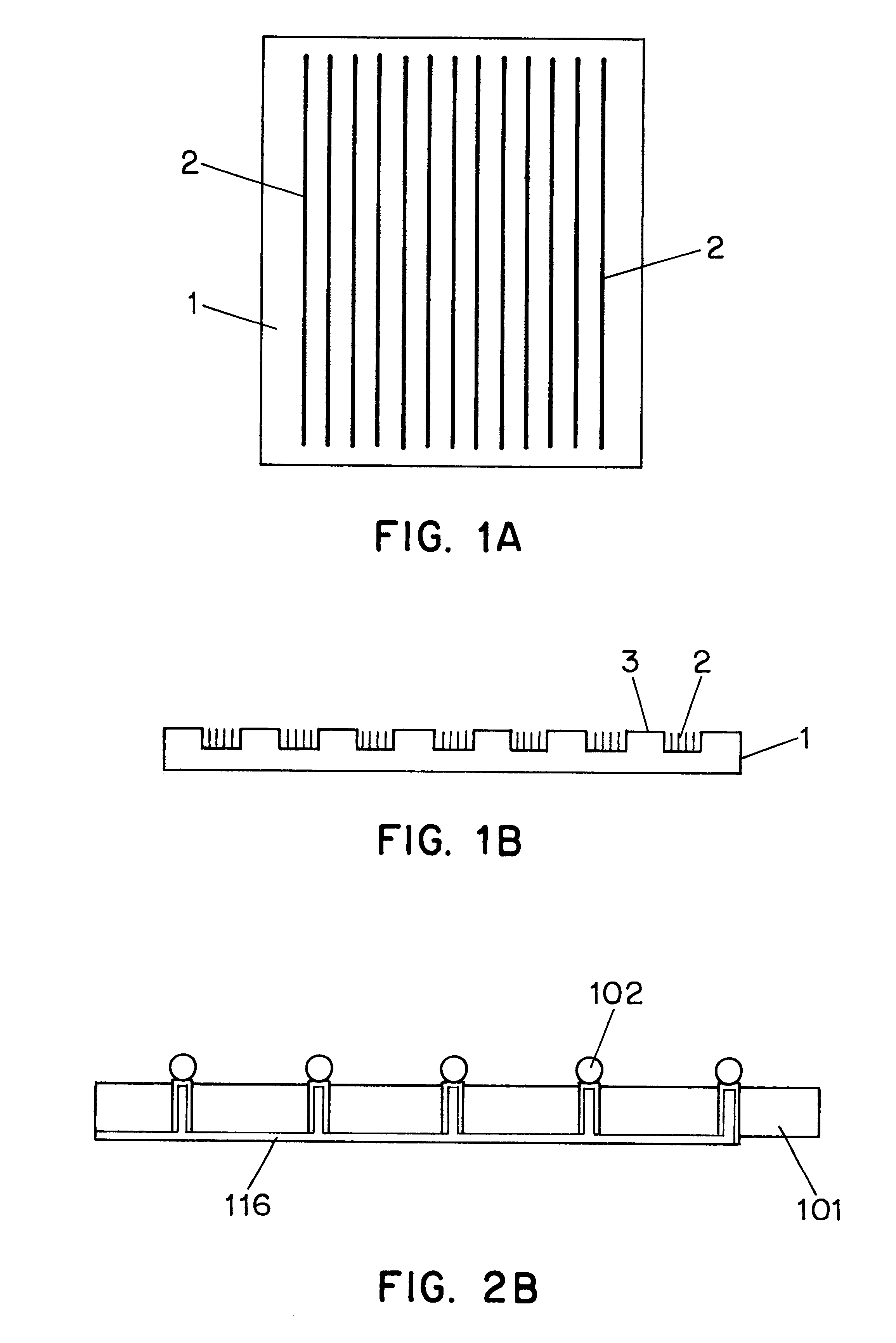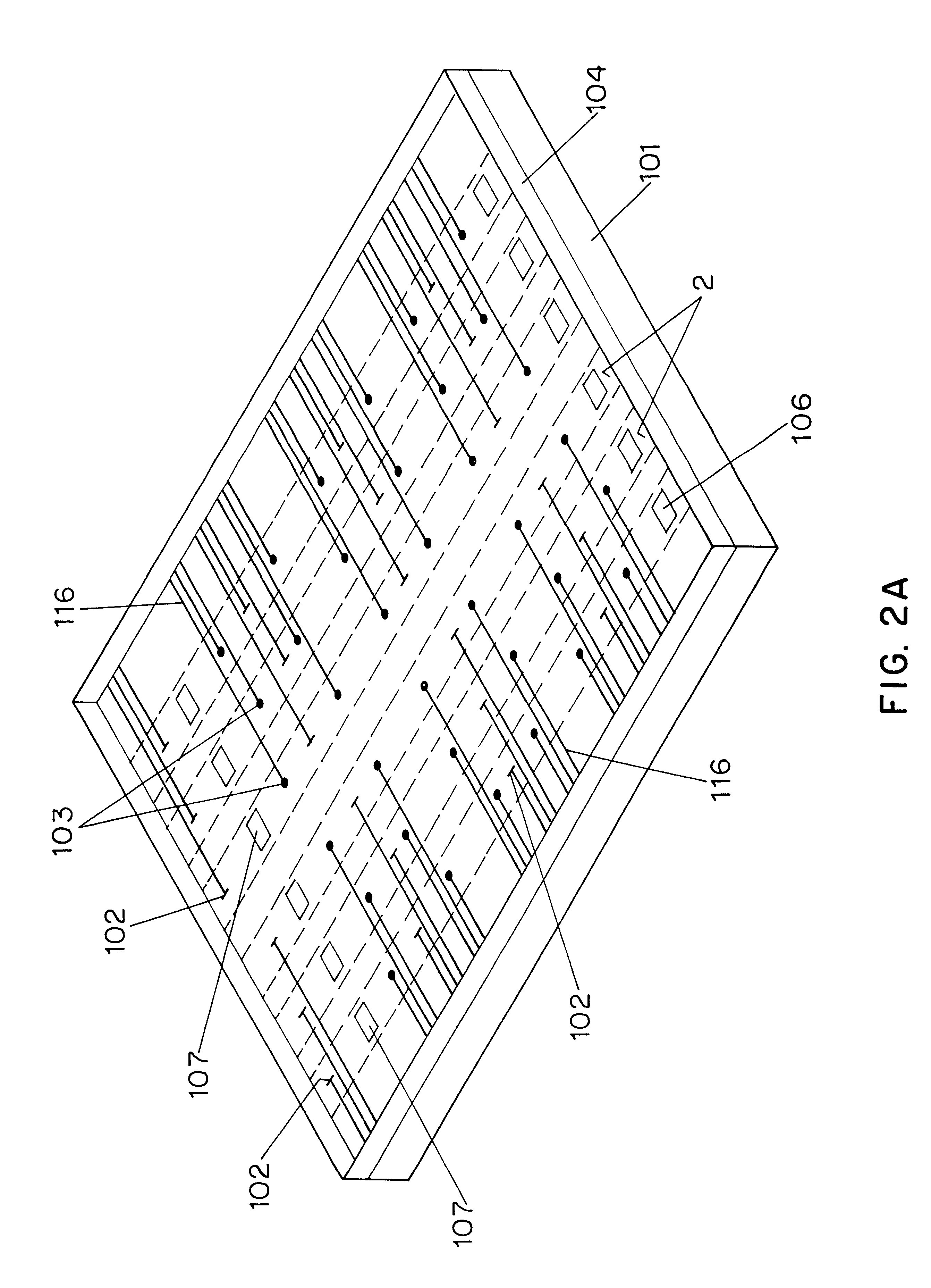Micro-electrophoresis chip for moving and separating nucleic acids and other charged molecules
a micro-electrophoresis and chip technology, applied in the direction of isotope separation, diaphragm, electrophoresis, etc., can solve the problems of insufficient detection sensitivity of detectors, inability to develop methods or apparatus for using electrophoresis in conjunction with recently developed miniature components for analyzing biomolecules, and insufficient sensitivity of small electrophoresis apparatuses such as the 43.times.50.times.0.45 mm
- Summary
- Abstract
- Description
- Claims
- Application Information
AI Technical Summary
Problems solved by technology
Method used
Image
Examples
example 2
In a two substrate system, small nucleotide fragments are separated from large fragments by switching the charges on electrodes during the course of electrophoresis. In FIGS. 9A-9C, the sample, 701, is loaded through the loading site, 702, into the separation matrix, 703, by a capillary pipettor, 704. As it is in a horizontal format, the loading site is gently topped up with buffer after the sample is loaded. Electrophoresis begins with the voltages between micro-electrodes, 705, as shown in FIG. 9A. After a short period of time, FIG. 9B, the sample separates into species, 706, with the smallest fragments moving the fastest, and electrophoresis is stopped. When electrophoresis restarts, FIG. 9C, the voltages across the electrodes are changed, such that fragments on one side of a break point, 708, are drawn in one direction, while fragments on the other side are drawn in another direction, as indicated by the arrows. An apparatus as noted may require a detector (not shown) to determi...
example 3
A further advantage of the instant invention, is the ability to move samples from one well to another for different treatments, such as in an integrated DNA diagnostic chip. As described in U.S. patent application Ser. Nos. 08 / 271,946 and 08 / 271,942 which are incorporated herein by reference, the most cost effective means of DNA diagnosis involves a hierarchical method of testing, wherein a series of analyses of increasing accuracy are employed to diagnose the presence or absence of genetic mutation. It is possible to integrate all the hierarchical steps on one chip, as illustrated in FIG. 10. FIG. 10 shows an integrated DNA diagnostic chip which uses the diagnostic method of the above noted patent application. A highly simplified discussion of the steps involved in the hierarchical method is provided below. In the first step, a group of exons of a gene to be diagnosed is examined for insertion and deletion mutations. In a reaction tube (not shown) the suspect exons of the patient a...
example 4
Research has shown that DNA, like other semi-rigid polymers in high concentration, has a natural tendency to form a liquid crystal at approximately 250 mg / ml. (Strzelecka T E; Davidson M W; Rill R L; Multiple liquid crystal phases of DNA at high concentration; Nature 1988; 331: 457-60; Rill R L; Liquid crystalline phase in concentrated aqueous solutions of Na+DNA. Proc. Natl. Acad. Sci. USA 1986; 83(2) 342-6). An embodiment of the invention suitable for running on the microelectrophoresis (2-10 micron) chip relies on the birefringent properties of DNA in a liquid crystal state.
Ultrathin layers of liquid crystals are routinely employed in the liquid crystal display industry. In certain orientations, liquid crystals have birefringent properties that cause substantial rotation of light and cause easily detectable light effects. Adapting this methodology to detection of DNA, it is observed that DNA in liquid crystal state acts as a birefringent material that will cause a substantially g...
PUM
| Property | Measurement | Unit |
|---|---|---|
| depth | aaaaa | aaaaa |
| length | aaaaa | aaaaa |
| length | aaaaa | aaaaa |
Abstract
Description
Claims
Application Information
 Login to View More
Login to View More - R&D
- Intellectual Property
- Life Sciences
- Materials
- Tech Scout
- Unparalleled Data Quality
- Higher Quality Content
- 60% Fewer Hallucinations
Browse by: Latest US Patents, China's latest patents, Technical Efficacy Thesaurus, Application Domain, Technology Topic, Popular Technical Reports.
© 2025 PatSnap. All rights reserved.Legal|Privacy policy|Modern Slavery Act Transparency Statement|Sitemap|About US| Contact US: help@patsnap.com



